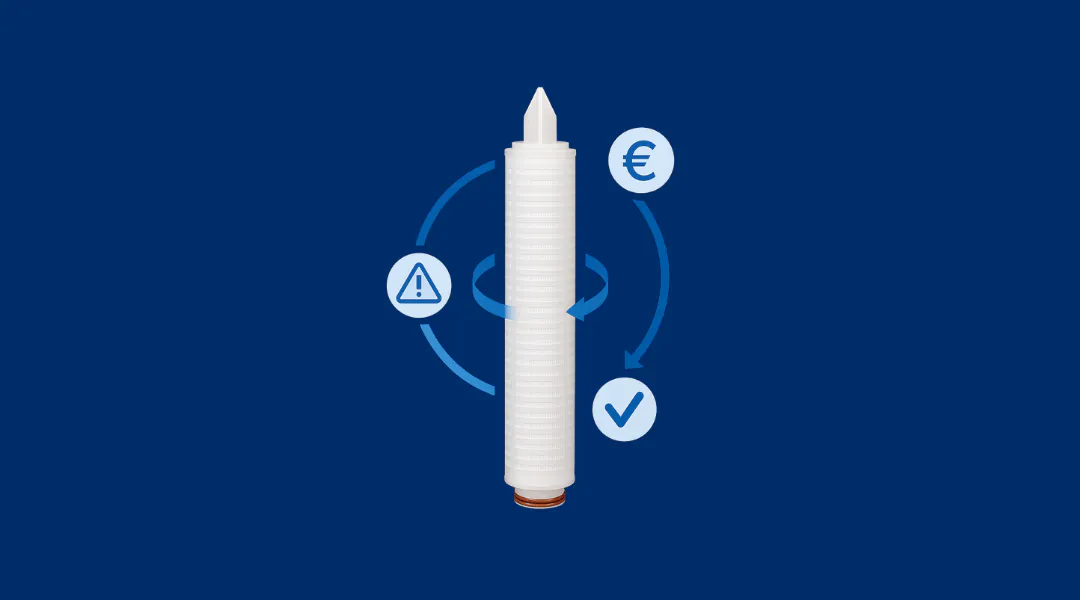Reusing Sterile Filters: Cost Saving or Hidden Risk?
At first glance, reusing sterile filters may seem like a smart way to reduce costs. But before you decide to reuse existing filters, it's essential to consider the risks, hidden costs, and potential alternatives.
At Van Borselen Filters, we’ve been supporting customers with critical filtration solutions for over 100 years. We often see that the desire to reuse filters stems from cost-saving efforts. However, the filter itself is rarely the biggest expense—and reuse often proves less cost-effective than expected.
Is your filter properly sized?
If you consistently have filter capacity left after each batch, you may be using an oversized filter. Switching to a smaller one can lead to savings without the need for reuse. However, keep in mind that a smaller filter may result in lower flow rates or higher pressure drop, which can affect process conditions.
Thinking about scaling up?
Increasing batch size while using the same filter spreads filtration costs over a larger product volume, reducing cost per unit. If you plan to scale up soon, investing in those efforts may be more strategic than pursuing a reuse strategy that could quickly become obsolete.
How big is the risk?
That largely depends on the application. In water filtration, filters can sometimes be reused with minimal validation. But when dealing with sterile APIs or final products, strict guidelines apply—focused on validation, traceability, and safety. A general rule: the further downstream the process, the stricter the requirements and the less feasible reuse becomes.
Lower-risk applications (potentially reusable):
-
Process water
-
Non-sterile APIs
-
Bulk ingredient containers
High-risk applications (typically single-use):
-
Sterile APIs
-
Final product
-
Sterile formulation components
Regulations are clear:
EU GMP Annex 1 mandates that filters must be discarded after use unless they have been explicitly validated for reuse.
FDA guidelines allow reuse under strict conditions, but only if safety and purity can be guaranteed, and no contamination or residues remain.
What does filter reuse really cost?
The potential savings must be weighed against:
-
Cleaning, sterilizing, drying, and storing used filters
-
Validation of the entire reuse process
-
SOP updates and staff training
-
Involvement from QA, Engineering, and Operations
-
Investment in equipment (e.g., autoclaves or test rigs)
And the risks include:
-
Biofilm formation from insufficient flushing
-
Loss of filter integrity
-
Increased leachables or endotoxins
-
Reduced bacterial retention
-
Batch rejection due to contamination
Often, a single rejected batch costs more than dozens of new filters.
What should a solid risk analysis include?
A thorough evaluation of filter reuse should address at least the following:
-
Batch integrity: prevent cross-contamination, ensure traceability
-
Cleaning method: effective and compatible with filter materials
-
Sterilization procedure: safe for both membrane and process
-
Number of reuse cycles: determine a safe reuse limit
-
Impact on product quality: monitor residues, pH, viscosity, pressure, etc.
-
Endotoxin formation: assess risks from dead bacteria
Only once these points are fully investigated and documented can you make an informed decision.
Are there better alternatives?
Fortunately, there are ways to reduce costs without the complexity of a reuse strategy:
-
Choose a smaller filter that better matches your batch size
-
Consider producing larger batches using your current filter
-
Switch to a more cost-effective filter that requires less validation
-
Implement a pre-filter
At Van Borselen Filters, we’re enthusiastic to help you explore these options. Sometimes, the right filter selection brings more value than reuse ever could.
Conclusion
Reusing sterile filters may seem attractive, but in practice it’s often more expensive, complex, and risky than anticipated. Unless you’re prepared to invest heavily in validation, procedures, and risk management, there are usually better alternatives for maintaining a cost-efficient filtration process.
Meer weten? Heeft u vragen of wilt u meer informatie? Vul hieronder uw gegevens in, en ons team neemt snel contact met u op. Wij helpen u graag verder!
Kom in contact

